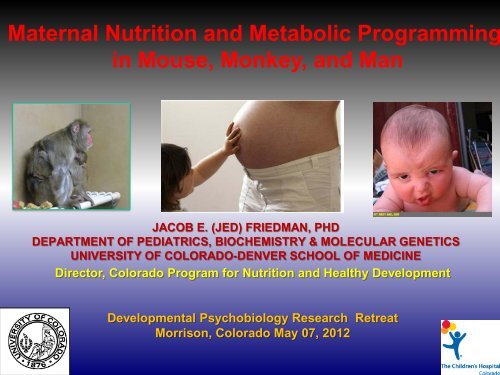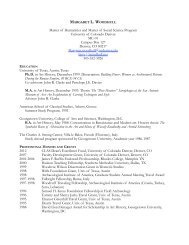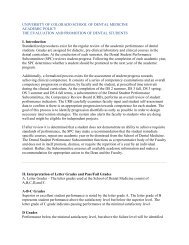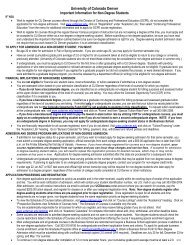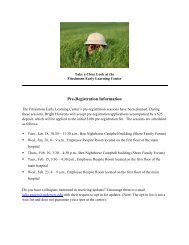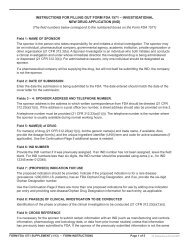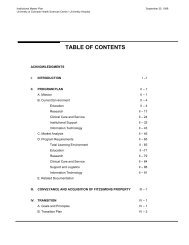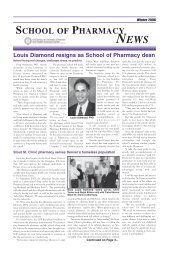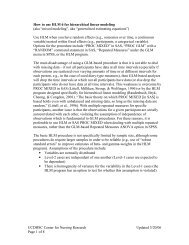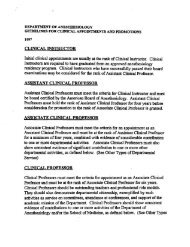Presentation - University of Colorado Denver
Presentation - University of Colorado Denver
Presentation - University of Colorado Denver
Create successful ePaper yourself
Turn your PDF publications into a flip-book with our unique Google optimized e-Paper software.
Maternal Nutrition and Metabolic Programming<br />
in Mouse, Monkey, and Man<br />
JACOB E. (JED) FRIEDMAN, PHD<br />
DEPARTMENT OF PEDIATRICS, BIOCHEMISTRY & MOLECULAR GENETICS<br />
UNIVERSITY OF COLORADO-DENVER SCHOOL OF MEDICINE<br />
Director, <strong>Colorado</strong> Program for Nutrition and Healthy Development<br />
Developmental Psychobiology Research Retreat<br />
Morrison, <strong>Colorado</strong> May 07, 2012
Acknowledgements:<br />
Oregon National Primate Research Ctr<br />
Kevin Grove, Ph.D.<br />
Dan Marks, MD, Ph.D.<br />
Antonio Frias, MD, PhD<br />
Diana Takahashi, MS.<br />
Staff and support Oregon National Primate<br />
Research Center, Beaverton Oregon<br />
NIH-RO1 DK060685, RO1 DK074643,<br />
R24 DK90964, P30 DK048520 , ADA<br />
<strong>University</strong> <strong>of</strong> <strong>Colorado</strong> Nutrition & Obesity<br />
Research -Center (NORC); <strong>University</strong> <strong>of</strong> <strong>Colorado</strong><br />
Maternal-Child Clinical Translational Research<br />
Center<br />
<strong>University</strong> <strong>of</strong> <strong>Colorado</strong>-<strong>Denver</strong><br />
Center for Proteomics:<br />
�Karen Jonscher, Ph.D.<br />
�Aga Kendrick, M.S.<br />
Baylor College <strong>of</strong> Medicine:<br />
Kjersti Agaard-Tillery, M.D. Ph.D.<br />
<strong>University</strong> <strong>of</strong> <strong>Colorado</strong>-<strong>Denver</strong><br />
Carrie McCurdy, Ph.D.<br />
Stephanie Thorn, Ph.D.<br />
Lynn Barbour, M.D.<br />
Teri Hernandez, Ph.D.<br />
Margaret Heerwagen, B.S.<br />
Becky De La Houssaye, M.S.<br />
Rachel Van Pelt, Ph.D.<br />
Michael Stewart, M.D.<br />
Sean Newsom, Ph.D.<br />
Kristen Boyle, Ph.D.<br />
David Brumbaugh, M.D.<br />
Rachel Janssen, M.S.<br />
Rebecca Aiken, M.S.
<strong>Colorado</strong> Program in Nutrition and Health Development<br />
Jed Friedman, Director, Lynn Barbour-Co-director<br />
Goals <strong>of</strong> the Program:<br />
• To understand basic mechanisms underlying the role <strong>of</strong><br />
nutrition and the environment on maternal-infant health in<br />
animal models that can be translated to humans.<br />
• To develop safe nutritional/interventional strategies to<br />
achieve a healthier pregnancy and improve newborn health<br />
during the first 1000 days <strong>of</strong> life.<br />
• To facilitate collaborative research within <strong>Colorado</strong> and<br />
beyond.<br />
• To provide education for trainees, medical pr<strong>of</strong>essionals, and<br />
the lay public.
<strong>Colorado</strong> Program for Nutrition and Healthy Development
Outline <strong>of</strong> Talk:<br />
1) The new science <strong>of</strong> Fetal Programming<br />
- Fetal Programming: What is it?<br />
- Maternal Obesity and the fetus:<br />
Response to an Epidemic<br />
2) Studies in Non-Human Primate<br />
3) Studies in Human pregnancy<br />
4) - Omega-3’s<br />
- Fat-1 mouse model<br />
5) Future Directions
Fetal Programming:<br />
The intrauterine environment can<br />
impact fetal development at both<br />
a morphological and a molecular<br />
level.<br />
An “adverse” environment can<br />
predispose an infant to later life<br />
diseases, such as obesity,<br />
diabetes, and CVD.
Oct. 6, 2010
How Big Is the Problem?<br />
% Women with BMI > 30<br />
(OBESE) (Overweight)<br />
Catalano OM, Ehrenberg HM. BJOG. 2006 Oct;113(10):1126-33.
March 18, 2010<br />
700,000 children and teens (2-19) in Southern California<br />
1/6 <strong>of</strong> children are obese (>95%)<br />
7% boys and 5% girls extremely obese<br />
“These kids face 10-20 years shorter life span and will<br />
develop health problems in their 20s that we typically see<br />
in 40-60 yr olds”<br />
Fatty Liver Disease in Obese Youth: 1 in 5.
Trends in child and adolescent overweight<br />
Age 6-11<br />
Age 12-19<br />
Age 2-5<br />
Note: Overweight is defined as BMI>=gender and weight-specific 95th percentile from the 2000 CDC<br />
Growth Charts. Source: National Health Examination Surveys II (ages 6-11) and III (ages 12-17),<br />
National Examination Surveys, I, II, III and 1999-204, NCHS, CDC.
World-Wide Childhood Obesity Epidemic<br />
Critical Early Life Factors affect Health<br />
Across the Lifespan<br />
Genes Gestational Exposure Post-natal Environment<br />
The Childhood Obesity Pipeline is Full and getting worse
NIH Consensus Conference,<br />
Sept 23-24, 2005 Bethesda MD<br />
The Maternal Intrauterine Environment and<br />
the Origins <strong>of</strong> Obesity<br />
• When does it Occur?<br />
• How does it Occur?<br />
• What can we do about it?<br />
“Programming” effects on Obesity, CV-disease, and Cancer
Prevalence (%)<br />
Prevalence <strong>of</strong> Type 2 DM In Pima Indians,<br />
by Mothers Diabetes in Pregnancy<br />
75<br />
60<br />
45<br />
30<br />
15<br />
0<br />
Offspring <strong>of</strong> non-diabetic mothers<br />
Offspring <strong>of</strong> pre-diabetic mothers<br />
Offspring <strong>of</strong> diabetic mothers<br />
5-9 10-14 15-19 20-24 25-29 30-34<br />
Age (years)<br />
Dabelea D, Pettitt DJ, J Mat. Fetal Med. 2000; 9:83.
Development is characterized by early windows <strong>of</strong> plasticity:<br />
.<br />
Cells in this window are highly sensitive to environmental stimuli that impact:<br />
- differentiation<br />
- death/proliferation<br />
- gene expression programs<br />
Fowden A L et al. Physiology 2006;21:29-37
The “Obese Environment”<br />
• Adipose Tissue Hypertrophy<br />
• Insulin Resistance<br />
• Hyperlipidemia<br />
• Hyperglycemia<br />
• Hyperinsulinemia<br />
• Inflammation<br />
But we see this kind <strong>of</strong> metabolic pr<strong>of</strong>ile somewhere else too…
Metabolic changes during pregnancy:<br />
In the mother, in order to mobilize energy stores<br />
and fuel fetal growth:<br />
Hyperlipidemia<br />
Hyperglycemia<br />
Insulin Resistance<br />
Adipose Hypertrophy<br />
What happens when obesity and pregnancy combine?
When the two combine: Maternal Obesity<br />
Significant evidence here<br />
Heerwagen et.al. AJP Review September 2010
Long Term Implications for Fetus<br />
• Obese infants are up to 2-9 times<br />
as likely to be obese as adults Baird J,<br />
BMJ 2005;331:929<br />
• Maternal BMI ≥ 30 conferred 25%<br />
obesity risk at age 4 (~3-fold) indep<br />
<strong>of</strong> BW Whitaker RC Pediatrics 2004;114:29<br />
• 25% <strong>of</strong> obese children age 4-10<br />
have IGT
Co-Morbidities <strong>of</strong><br />
Childhood Obesity<br />
• Obesity has tripled in last 2 decades:<br />
– 20-25% <strong>of</strong> girls 11-15 are obese<br />
• Type 2 DM in children/adolescents has ↑ 300%<br />
– Type 2 > Type 1 in children 10-19 in most ethnicities<br />
• Pediatric fatty liver disease 13% children<br />
• 1 in 3 children born in the year 2000 will<br />
develop DM in their lifetime
Diabetes "massive challenge" as cases hit 366 million<br />
LONDON | Tue Sep 13, 2011 7:36am EDT<br />
(Reuters) - The number <strong>of</strong> people living with diabetes has soared to 366 million, and the<br />
disease kills one person every seven seconds, posing a "massive challenge" to healthcare<br />
systems worldwide, experts said on Tuesday.<br />
The vast majority <strong>of</strong> those with the disease have Type 2 -- the kind linked to poor diet, obesity<br />
and lack <strong>of</strong> exercise -- and the problem is spreading as people in the developing world adopt<br />
more Western lifestyles.<br />
Worldwide deaths from the disease are now running at 4.6 million a year.
Global projections for the diabetes epidemic: 2010–2030 –Nature Reviews-<br />
Endocrinology, 2012
World-wide Food Insecurity
The Developing World is catching up<br />
NYTimes, 3-11-2012
THE FAT-THIN INDIAN BABY<br />
Caucasian, 3500g Indian, 2700g<br />
8% fat<br />
16% fat<br />
Yajnik, Proc Nutr Soc; 2004
Fetal Origin <strong>of</strong> Adult Disease<br />
Fetal Growth Restriction:<br />
• Diabetes<br />
• Adiposity<br />
• Cardiovascular disease<br />
• Osteoporosis<br />
Excessive Fetal Growth:<br />
• Diabetes<br />
• Obesity<br />
• Cardiovascular disease<br />
• Some cancers<br />
Is the mechanism<br />
The same?
High Risk Outcomes<br />
In Low or High** Birthweight Adults<br />
Insulin resistance **<br />
Hyperglycemia **<br />
Islet dysfunction **<br />
Dyslipidemia **<br />
Endothelial dysfunction<br />
Hypertension **<br />
Prothrombotic State<br />
Cardiac vulnerability **<br />
Increased ANS activity<br />
Appetite dysregulation **<br />
Reduced immune function<br />
Osteoporosis
Infant Adiposity vs. BW<br />
Catalano, Am J Clin Nutr 2009:<br />
• 47% <strong>of</strong> difference in birth weight<br />
related to Fat.<br />
• SGA vs AGA vs LGA have about the<br />
same lean body mass.<br />
• AGA infants <strong>of</strong> GDM or Obese moms<br />
have higher %fat than AGA infants <strong>of</strong><br />
controls moms.<br />
*Fat Accretion by Species:<br />
Rats/Mice 1%<br />
Sheep: 2-3%<br />
Non-human Primates: 3-4%<br />
Guinea Pigs ~10-14%<br />
Humans: 12-15%<br />
Infant DEXA at 2 wks <strong>of</strong> Age:<br />
Mother: Lean Obese & GDM<br />
BW = 3370g<br />
Fat = 7.7%<br />
BW = 2893g<br />
Fat = 16.8%
Top Intrauterine Contributors to Neonatal Adiposity<br />
� Maternal Insulin Resistance (could explain chunk <strong>of</strong><br />
below)<br />
� Maternal BMI<br />
� Hyperglycemia<br />
� Maternal TG and FFA (Lipolysis, CM-TG, VLDL-TG?;<br />
indep <strong>of</strong> IR?)<br />
� Maternal High Fat Diet (Indep <strong>of</strong> mat obesity through<br />
changes infant metabolome, appetite regulation,<br />
behaviors, NAFLD, mitochondrial oxidation)<br />
� Excess Gestational Weight Gain<br />
� Maternal Inflammatory Cytokines (change in placental<br />
gene expression and transport)<br />
� What About?<br />
� Oxidative Stress and Increased Lipid Exposure in early life?<br />
� Placental and Fetal Growth Factors (fetal hyperinsulinemia<br />
response to hyperglycemia, placental IGFs)<br />
� Psychological stressors? ↑CRH and IL1β in mom; ↑GR and<br />
insulin in fetus.
First take home message:<br />
Its not all about birth weight<br />
Adiposity Matters!
Taveras E, et al. Pediatrics, 2009;123:1177-83.<br />
• Faster weight gain 0-3 months is<br />
positively associated with adiposity<br />
at 21 yo.<br />
Leunissen RW et al. JAMA, 2009; 301(21):2234-42.<br />
• Weight gain 0-9 months is positively<br />
associated with BMI at 17 yo (p=.002)<br />
even after adjustment for parents’<br />
BMI, sex, and birthweight<br />
Larkjaer A et al. Am J Clin Nutr, 2010; 91:1675-83.
Figure 1. Complex Pathogenesis <strong>of</strong> Type 2 Diabetes.<br />
Genetic and environmental factors may influence the risk <strong>of</strong> diabetes through<br />
the pathways illustrated in the figure or through as-yet-unidentifed mechanisms<br />
affecting insulin sensitivity and/or insulin secretion. Kahn, CR, Cell Metabolism , 2008.
Prevalence (%)<br />
Prevalence <strong>of</strong> Diabetes in Offspring from<br />
Women with Diabetes -Pima Indians<br />
70<br />
60<br />
50<br />
40<br />
30<br />
20<br />
10<br />
0<br />
Offspring <strong>of</strong>:<br />
NonDiabetic<br />
PreDiabetic<br />
GDM<br />
5-9 10-14 15-19<br />
Age (yr)<br />
20-24 25-29 30-34<br />
Dabelea, Knowler, Pettitt J MFM 2000:9:83
Obese Pregnancy and Fetal Nutrients:<br />
nd Take home message:It’s not just glucose…<br />
Most Large for Gestational Age (LGA) infants are born to<br />
mothers without GDM.<br />
In multivariate analyses <strong>of</strong> pregnant women, glucose<br />
accounted for
Epigenetics:<br />
It’s not what you have, but<br />
what you do with it that counts!<br />
Modifications to DNA/chromatin<br />
Effect TF binding and chromatin<br />
structure<br />
Established largely during early<br />
development<br />
Why our body is composed <strong>of</strong><br />
different cell types, though same<br />
genetic sequence.<br />
Time Magazine, February 19, 2010
NEWS & VIEWS<br />
Childhood obesity—methylate now, pay later?<br />
Choudhury, M. & Friedman, J. E. Nat. Rev. Endocrinol. 7, 439–440 (2011).<br />
A recent report has found an association between the methylation status <strong>of</strong><br />
specific genes in human fetal tissue and the subsequent development <strong>of</strong><br />
childhood adiposity in two longitudinal cohorts. Would epigenetic analysis at<br />
birth, therefore, have utility in identifying future risk <strong>of</strong> obesity?
Fetal Biochemistry:<br />
Limited capacity for de novo lipogenesis in the fetus implies<br />
that most precursors for fetal fat accretion are supplied by<br />
transfer <strong>of</strong> maternal substrates derived from lipid rather than<br />
from glucose sources.<br />
NEFA<br />
TG<br />
lipase<br />
lipase<br />
Placenta Lipid droplet<br />
Triglycerides<br />
Palmitate<br />
phospholipids<br />
PLA2<br />
PLA2<br />
PUFAs<br />
PUFAs<br />
Omega-3<br />
Omega-3<br />
Omega-6<br />
Omega-6<br />
Fatty Acid Oxidation is present in most fetal tissues (liver,<br />
heart, etc) during development. Therefore the concept that<br />
glucose provides the majority <strong>of</strong> fuel necessary for fetal<br />
energy metabolism may need to be re-examined.
Adult<br />
NAFLD<br />
Insulin Resistance<br />
Obesity<br />
Appetite, behavior<br />
Diabetes
Nature Medicine<br />
Vol:18,<br />
363–374:<br />
(2012)<br />
“Metainflammation”
Maternal diet-induced obesity alters mitochondrial activity and redox<br />
status in mouse oocytes and zygotes. PLoS One. 2010 Apr 9;5(4):e10074.<br />
Igosheva et al.<br />
Abnormal mitochondrial distribution<br />
and increased activity in oocytes and<br />
zygotes from DIO mice<br />
ROS production<br />
Glutathione levels<br />
Maternal DIO increases ROS generation<br />
And depletes glutathione in oocytes & zygotes.
Mitochondrial Defects<br />
Obesity is accompanied by<br />
� Reduced SkM Mitochondrial Function (OXPHOS)<br />
� Incomplete FAO<br />
� Decreased Mitochondrial Biogenesis<br />
� Impaired Insulin Action
Metabolic Programming in the<br />
Fetus:<br />
Is it simply a matter <strong>of</strong> FAT?
Collaborative Obesity Research<br />
<strong>University</strong> <strong>of</strong> <strong>Colorado</strong> & Oregon National<br />
Primate Research Center, <strong>University</strong> <strong>of</strong> Utah<br />
Long-Term Goal:<br />
• To develop a Non-Human Primate Model to study the<br />
effects <strong>of</strong> Maternal Diet, Obesity and GDM on the<br />
development <strong>of</strong> metabolic systems (liver, muscle, px, brain)<br />
in utero, and beyond.
Benefits and Obstacles to<br />
working in NHP model<br />
• Longer gestation period<br />
(175d)<br />
• Similar Placentation<br />
• Organ development<br />
occurs in utero<br />
– pancreas, brain, adipose<br />
• Perform invasive studies<br />
that cannot be done in<br />
humans or fetal mice<br />
• Heterogenity<br />
• Free-living<br />
– Difficult to control<br />
food intake and<br />
exercise<br />
• Studies/data<br />
collection take a lot<br />
longer<br />
• Collaborative<br />
• Expensive<br />
• Heterogenity
STUDY QUESTIONS<br />
1. Does Maternal Diet Influence<br />
Fetal Mitochondrial<br />
Biogenesis and Subsequent<br />
Mitochondrial Function?<br />
2. Does Skeletal Muscle Insulin<br />
Resistance Begin In Utero?
A Primate Model<br />
Japanese<br />
Macaques<br />
@ ONPRC
CTR = 15% Fat Calories<br />
MODEL<br />
Young adult female Japanese macaques - CTR<br />
or HFD for 2-6 years<br />
HFD = 35% Fat Calories – Western Style Diet<br />
Diet sensitive (HFD-S) vs resistant (HFD-R)<br />
Diet reversal group (DR) – HFD animals switched<br />
back to CTR diet just prior to pregnancy
High Fat Diet Animals<br />
High Fat Diet Resistant<br />
(HFD-R)<br />
Triglycerides<br />
Saturated FFA<br />
Frias AE et al., Endocrinology 2011<br />
McCurdy CE et al, JCI, 2009<br />
Grant WF et al., Plos One, 2011<br />
High Fat Diet Sensitive<br />
(HFD-S)<br />
Body Weight<br />
Adiposity<br />
Insulin<br />
Leptin<br />
Triglycerides<br />
Saturated FFA
▪Maternal HF diet/obesity leads to an early<br />
Fetal exposure (day 130) to elevated plasma TG<br />
J. Clin. Invest. 2009
Fetal Hepatic Pathology Under<br />
Conditions <strong>of</strong> Maternal Obesity<br />
Fetal liver triglycerides, mg/g<br />
8.0<br />
6.0<br />
4.<br />
0<br />
2.0<br />
0<br />
Maternal<br />
Diet<br />
* p
▪Elevated Fetal Liver TG occurred in all HF Y2-Y4 G130 fetuses<br />
REGARDLESS <strong>of</strong> maternal diet responsiveness<br />
McCurdy, CE et al. J. Clin. Invest. 119(2), 2009.
-Elevated Stress Response in Fetal Y2-Y3 Livers<br />
Elevated Stress in Response 3 pattern in Fat Y2/Y3<br />
Fetal Livers<br />
rd Trimester- G130<br />
C-FOS p-JNK1 p38 MAPK<br />
McCurdy, CE et al. J. Clin. Invest. 119(2), 2009.
Mito Biogenesis in Skeletal Muscle<br />
Copy Number (mtDNA/Nuc DNA)<br />
1000<br />
800<br />
600<br />
400<br />
200<br />
0<br />
N=5-8 for males<br />
*<br />
Males<br />
CON HFD_R HFD_S
Model showing loss <strong>of</strong> Sirtuin 3 function in fatty liver:<br />
Potential impact on reduced mitochondrial ETC activity<br />
Lys<br />
NADH--->NAD
Why Does the Fetus Store Excess Lipids in<br />
Liver and other organs?<br />
• Excess HFD exposure exceeds fetal storage capacity<br />
during normal development <strong>of</strong> adipose tissue depots.<br />
• Hormonal factors (such as fetal hyperinsulinemia)<br />
drive lipid storage.<br />
• Exposure to increased dietary n6/n3 ratio promotes<br />
inflammation and causes metabolic re-programming?
Chow<br />
Maternal Fetal Breast Milk<br />
*<br />
*<br />
Plos One (2011)<br />
The increased n6/n3 ratio in the<br />
chow is made worse in the fetus<br />
N3s are critical for development<br />
* *<br />
*<br />
*
Placental function is key to a healthy<br />
pregnancy and normal fetal development<br />
• Hyperinsulinemia and<br />
hyperglycemia (GDM) cause<br />
complications in placental<br />
function.<br />
• What are the potential impacts<br />
<strong>of</strong> HFD consumption?<br />
– Inflammation<br />
– Vascular dysfunction<br />
Ragavendra et al., Placenta 2001
Placenta Histology<br />
Control<br />
Pregnancy complications resulting in fetal death:<br />
CTRs 1 in 5 yrs (3%)<br />
HFD 8 in 5 yrs (24%); 7 in HFD-S animals<br />
HFD-S<br />
Frias et al, Endocrinology 2011
Maternal Circulation Control vs HF diet Fetal Placenta<br />
These are actually decreases in<br />
inflammatory markers.<br />
Sex differences in inflammation<br />
associated with obesity.<br />
These two significant differences<br />
were not observed in fetal <strong>of</strong>fspring<br />
Frias et al, Endocrinology 2010
Fetal circulating cytokines<br />
Includes both HFD-S and HFD-R <strong>of</strong>fspring<br />
McCurdy CE et al, JCI, 2009
Summary - Placenta<br />
Dietary Lipids<br />
`<br />
MATERNAL Fetal<br />
Hyperglycemia<br />
hyperinsulinemia<br />
Postprandial sat. FFA<br />
N3-FFA<br />
N6/N3 ratio<br />
Placenta<br />
Cytokines<br />
TLR4<br />
Cytokines<br />
Oxidative damage<br />
Insulin resistance<br />
Metabolic mal-programming<br />
Pregnancy complications<br />
Postprandial sat. FFA<br />
N3-FFA<br />
N6/N3 ratio
Summary: Maternal HFD:<br />
• Significant impact on placental function & development<br />
– Cytokine production – n6/n3 increased in developing fetus<br />
– Decreased placental function – exacerbated in HFD-S mothers<br />
• Increased early adiposity and glucose intolerance<br />
– Fatty liver (Inflammation, steatosis), insulin resistance maintained in<br />
Juvenile livers.<br />
– Epigenetics –HSP70, Bmal1 (clock gene family) (FASEB J, 2010).<br />
– Pancreatic islet hyperplasia<br />
– Hyperphagia <strong>of</strong> palatable diets<br />
– Abnormalities in the melanocortin system (Endocrinology 2010).<br />
• Social Behavior<br />
– Decreased Serotonin (J Neurosci, 2010)<br />
– Female Offspring – increased anxiety<br />
– Male <strong>of</strong>fspring – increased aggressive behavior<br />
– Both sexes display decreases in social behavior<br />
• Is NOT solely dependent on maternal obesity
Juvenile<br />
Hypotheses<br />
1. Maternal high fat diet exposure will result in hepatic<br />
steatosis, inflammation and insulin resistance in<br />
juvenile <strong>of</strong>fspring at 1 yr <strong>of</strong> age.<br />
2. These metabolic abnormalities will be exacerbated<br />
when <strong>of</strong>fspring are fed a high fat diet after weaning<br />
to 1 yr <strong>of</strong> age.<br />
3. Mechanism may involve persistent activation <strong>of</strong><br />
inflammatory pathways in liver
Consumption During the Food Preference<br />
Testing is Influenced by Current Diet,<br />
Maternal Diet, and Age<br />
*<br />
*<br />
Age/Experience with post-weaning diet:<br />
F 1,11=93.57, p
Temperament Assessment at 4 months <strong>of</strong><br />
Age<br />
Human Intruder Test<br />
Acclimation (12 min)<br />
Pr<strong>of</strong>ile (2 min)<br />
Control period (2 min)<br />
Stare (2 min)<br />
Control period (2 min)<br />
Novel fruit test (kiwi; 5 min)<br />
Novel toy 1 (Mr. potato head; 5 min)<br />
Novel toy 2 (hanging toy; 5 min)<br />
Novel toy 3 (snake; 5 min)<br />
Anxiety:<br />
•Latency to examine novel objects<br />
•Response to Human Intruder<br />
•Fear grimace<br />
•Teeth grind<br />
•Cage bite<br />
•Escape<br />
•Hiding<br />
•Stereotypy<br />
•Scratching<br />
Aggression:<br />
•Threats<br />
•Attacks
Offspring from HFD fed mothers<br />
exhibit increased latency to explore<br />
novel objects suggesting increased<br />
anxiety<br />
*
Maternal and post-weaning HFD increases<br />
early measures <strong>of</strong> insulin resistance
Maternal HFD increases liver triglycerides
Macrophage/Kupffer Cell TLR Signaling<br />
Macrophage/KC<br />
TLR2/6<br />
Bacteria<br />
LPS<br />
TLR1/6<br />
TLR5<br />
NFκB<br />
TNFα, IL6, TGFβ<br />
Crispe. Annu. Rev. Immunol. 2009;27:147-63<br />
Sat fatty<br />
acids<br />
TLR4<br />
TRIF<br />
ds<br />
RNA<br />
“Apoptosis”<br />
TLR3<br />
IRF3<br />
IFNα<br />
IFNβ<br />
Viral ss<br />
RNA<br />
RIG-I MDA-I<br />
IPS-1
(N=2-3 per group)<br />
Increased inflammatory response<br />
in Kupffer cells from animals exposed to<br />
maternal HFD – 1 year later<br />
Similar results for TNFa and IL-6<br />
Kupffer Cells = 100X ↑ in IL-1b vs Hepatocytes
Non-human primate Data: Focal Cell Death<br />
G130 fetal livers show increased lipids, oxidative stress and apoptosis with<br />
maternal HFD….<br />
Oil Red-O<br />
4-HNE<br />
CONTROL HFD<br />
McCurdy et.al. J. Clin. Invest. 119:323–335 (2009)<br />
CONTROL HFD<br />
Grant et.al. PLoS One. 2011 Feb 25;6(2):e17261.
Putative Natural History <strong>of</strong> Fatty Liver Disease<br />
“first hit”<br />
“second hit”<br />
Steatosis<br />
US adults: 20-30%<br />
Obese adults: 60%<br />
US kids 9-19*: 17%<br />
Obese kids: 55%
Our Approach in Moms & Infants<br />
–Work in Progress<br />
Hepatic Fat<br />
Subcutaneous<br />
Fat<br />
Visceral Fat<br />
Can we observe physiologic differences in harmful fat deposition that predate<br />
Influence <strong>of</strong> diet and lifestyle?
1<br />
Lean<br />
Obese<br />
GDM Hx<br />
Screen:<br />
Consent<br />
H&P<br />
Dietitian<br />
12<br />
2<br />
NIH RO1: Regulation <strong>of</strong> Maternal Fuel Supply<br />
And Neonatal Adiposity – 9 VISITS<br />
DEXA/<br />
CGMS #1<br />
3 days<br />
Prepared<br />
Diet<br />
Liquid Feed #1<br />
Day 4 <strong>of</strong> CGMS<br />
Fasting Blood<br />
BMR and RER<br />
Liquid Meal: q20 min<br />
Blood draws x 4 hrs<br />
13 14 15 16 17 18 19 20 21 22 23<br />
3<br />
4<br />
CGMS #2-<br />
Biopsy<br />
AT biopsy<br />
on Day 1<br />
3 days<br />
Prepared<br />
Diet<br />
24<br />
5<br />
Liquid Feed #2<br />
Day 4 <strong>of</strong> CGMS<br />
Fasting Blood<br />
BMR and RER<br />
Liquid Meal: q20 min<br />
Blood draws x 4 hrs<br />
6 7<br />
Fetal U/S #1<br />
3-hr OGTT<br />
25 26 27 28 29 30 31 32 33 34 35<br />
Obtain placenta<br />
and Cord Blood<br />
9<br />
Fetal<br />
U/S #2<br />
37 38 39<br />
36<br />
8<br />
40<br />
Delivery<br />
Neonatal Blood/<br />
Anthropometrics<br />
2 weeks PP<br />
Maternal DEXA<br />
Neonatal DEXA/<br />
Anthropometrics
Study Groups: 20 each: Normal Weight (NW) (Pre-Pregnant BMI between 19.0 – 24.0)<br />
Overweight/Obese (OW/Ob) (Pre-Pregnant BMI between 26.0 – 39.9)<br />
Gestational Diabetic (GDM) (Pre-Pregnant BMI between 26.0 – 39.9)<br />
Type II Diabetic (T2D) (Pre-Pregnant BMI between 26.0 – 39.9)<br />
Birth<br />
28-38 weeks<br />
Recruitment 48 hours 2 weeks 1 month<br />
1 2 months 3 months<br />
In Hospital:<br />
Infant<br />
• Anthropometry<br />
• Blood Sample 2<br />
Maternal<br />
• Colostrum<br />
Collection<br />
• Weight<br />
• Chart Review<br />
(Pregnancy)<br />
Clinic Visit:<br />
Infant<br />
• Anthropometry<br />
• PeaPod<br />
• Infant Feeding<br />
Questionnaire<br />
• Feeding Practices<br />
Questionnaire<br />
• Stool<br />
• Urine<br />
Maternal<br />
• Weight<br />
• Fasting Milk<br />
Collection<br />
• Fasting Blood<br />
Sample<br />
• 3-day Food Recall<br />
• Physical Activity<br />
Questionnaire<br />
• Health History<br />
• Optional: Stool<br />
Home Visit:<br />
Infant<br />
• Anthropometry<br />
• Infant Feeding<br />
Questionnaire<br />
• Optional: Stool<br />
Maternal<br />
• Weight<br />
• Fasting Milk<br />
Collection<br />
Study Design:<br />
Home Visit:<br />
Infant<br />
• Anthropometry<br />
• Infant Feeding<br />
Questionnaire<br />
• Optional: Stool<br />
Maternal<br />
• Weight<br />
• Fasting Milk<br />
Collection<br />
Home Visit:<br />
Infant<br />
• Anthropometry<br />
• Infant Feeding<br />
Questionnaire<br />
• Optional: Stool<br />
Maternal<br />
• Weight<br />
• Fasting Milk<br />
Collection<br />
1 At recruitment, participants will be provided with lactation support materials and breast pump if desired.<br />
2 Infant blood sample to be collected at the time <strong>of</strong> the routine 48 hour infant screening blood sample.<br />
4 months<br />
Clinic Visit:<br />
Infant<br />
• Anthropometry<br />
• PeaPod<br />
• Infant Feeding<br />
Questionnaire<br />
• Feeding Practices<br />
Questionnaire<br />
• Blood Sample<br />
(Heel Stick)<br />
• Stool<br />
• Urine<br />
Maternal<br />
• Weight<br />
• Fasting Milk<br />
Collection<br />
• Fasting Blood<br />
Sample<br />
• 3-day Food Recall<br />
• Physical Activity<br />
Questionnaire<br />
• Health History<br />
• Optional: Stool
Composition<br />
•Calories<br />
oLactose<br />
oProtein<br />
oFat<br />
•Glucose<br />
•Fatty Acid<br />
Pr<strong>of</strong>ile*<br />
•Free Fatty Acids<br />
•Triglycerides<br />
Composition<br />
• Glucose<br />
• RBC Membrane Fatty<br />
Acid Composition*<br />
• Free Fatty Acids<br />
• Triglycerides<br />
• Hb-A1C<br />
Breast Milk (6 samples/Participant = 480 total samples)<br />
Cytokines<br />
•IL-6*<br />
•IL-8*<br />
•IL-10*<br />
•TNF-α*<br />
•IFN-γ*<br />
•CRP<br />
Cytokines<br />
•IL-6*<br />
•IL-8*<br />
•IL-10*<br />
•TNF-α*<br />
•IFN-γ*<br />
•CRP<br />
Biochemical Analyses<br />
Hormones &<br />
Adipokines<br />
•Insulin<br />
•Leptin<br />
•Adiponectin<br />
•Ghrelin (total)<br />
•Ghrelin (acylated)<br />
Maternal Blood (2 Samples/Participant = 160 total samples)<br />
Hormones &<br />
Adipokines<br />
•Insulin<br />
•Leptin<br />
•Adiponectin<br />
•Ghrelin (total)<br />
•Ghrelin (acylated)<br />
Antioxidants Microbiota<br />
• Total antioxidant • Probiotic Content*<br />
capacity<br />
• DPH Radical<br />
Scavenging Activity<br />
• Catalase Activity<br />
Oxidative Stress<br />
•F2-Isoprostanes<br />
•Oxidized-LDL<br />
•TBARS<br />
•8-OH-dG<br />
•4-HNE<br />
Infant Urine and Stool (2 Samples/Participant = 160 total samples)<br />
Oxidative Stress (urine)<br />
•F2-Isoprostanes<br />
Oxidative Stress<br />
•F2-Isoprostanes<br />
•Oxidized-LDL<br />
•TBARS<br />
•8-OH-dG<br />
•4-HNE<br />
Microbiota (stool)<br />
• Intestinal Microbiome Pr<strong>of</strong>ile*<br />
* All cytokines except CRP will be analyzed on a multiplex panel, microbiota analyses, fatty acid pr<strong>of</strong>ile, and<br />
membrane fatty acid composition will be analyzed in the labs <strong>of</strong> Dr. Daniel Frank and Dr. Mary Harris, respectively.<br />
All other analyses can be undertaken in our lab, but analytes highlighted in purple are <strong>of</strong>fered by the CTRC core<br />
labs.
Key Outcome: Infant Infant DEXA DEXA at 2 wks at <strong>of</strong> 2 Age: Weeks <strong>of</strong> Age<br />
Mother: Obese & GDM Mother: Lean Normal GT<br />
Birth weight = 2.9 kg<br />
body fat = 16.8%<br />
Birth weight = 3.4 kg<br />
body fat 7.7%
Neonatal %Body Fat<br />
Correlation Between Neonatal % Body Fat and<br />
Change in Maternal Fasting TGs<br />
20<br />
18<br />
16<br />
14<br />
12<br />
10<br />
8<br />
6<br />
4<br />
2<br />
R 2 = 0.831<br />
p = 0.001<br />
r=0.890<br />
0 20 40 60 80 100 120<br />
Maternal ∆ Fasting Triglycerides (Late - Early Gestation)<br />
Neonatal % Body Fa<br />
20<br />
18<br />
16<br />
14<br />
12<br />
10<br />
8<br />
6<br />
4<br />
2<br />
0<br />
r =0.110<br />
15 20 25 30 35 40 45<br />
Maternal % Body Fat
18 obese mothers w/ GDM<br />
17 lean mothers<br />
Exclusion Criteria:<br />
Pre-Pregnancy Diabetes<br />
IUGR<br />
Premature delivery<br />
NICU admission<br />
birth<br />
Single study visit<br />
1-3 weeks <strong>of</strong> age<br />
Pea Pod<br />
MRI<br />
MRS<br />
Anthropometrics<br />
Feeding<br />
Questionnaire
Roland-Valadez E et al. Ann Hepatol, 2008.
SubQ<br />
Fat<br />
Adiposity Outcomes<br />
Normal Weight Mothers (n=13) Obese/GDM Mothers(n=12)<br />
Outcome Mean (SD) Mean (SD) p-value*<br />
PEA POD (% body fat) 13.1(5.0) 14.7 (3.0) NS<br />
MRI subcutaneous fat (cm 3 ) 707 (138) 777 (159) NS<br />
Sum Skin Folds (mm) 9.9 (2.0) 11.7 (1.3)
Variable ß - coefficient P-value<br />
Maternal Pre-pregnancy BMI 0.03170 0.0456<br />
Infant Sex 0.20682 0.4877<br />
Infant Age at Study -0.00480 0.9620<br />
Infant Total Adiposity by Peapod 0.03540 0.5510<br />
-after adjusting for sex, age, and overall adiposity, the infant’s liver fat increases<br />
over 3% for every 1 kg/m2 increase in maternal pre-pregnancy BMI.
Conclusions – Spectroscopy Data<br />
• Maternal pre-pregnancy BMI is the strongest<br />
predictor <strong>of</strong> early liver fat deposition<br />
• This appears to be independent <strong>of</strong> total<br />
adiposity.<br />
• Maternal obesity/GDM will predispose infants<br />
to increased visceral fat storage?
Fetal Hepatic Fat Accumulation<br />
Oxidative Stress<br />
Inflammation<br />
Gluconeogenesis<br />
Recruitment and<br />
Activation <strong>of</strong> Bone<br />
Marrow WBC<br />
Precursors<br />
Consequences <strong>of</strong> Maternal Overfeeding on Fetal Liver<br />
Lifelong Increased Risk <strong>of</strong> a<br />
Proinflammatory Response<br />
to Overnutrition<br />
US adults: 20-30%<br />
Obese adults: 60%<br />
US kids 9-19*: 17%<br />
Obese kids: 55%<br />
Placental Inflammation<br />
Placental Nutrient Transfer<br />
Excess FFA/TG Delivery
How do we modify this?<br />
Reduce inflammation, insulin resistance, hyperlipidemia…<br />
Pregnant population limits drug options, especially in<br />
non-diabetic patients…<br />
• Pre-pregnancy lifestyle modifications<br />
• Controlling gestational weight gain<br />
• Exercise<br />
• Dietary modifications
Western Diet:<br />
High Saturated Fat<br />
High Omega-6<br />
Low Omega-3<br />
Types and sources <strong>of</strong> dietary fat:<br />
Hunter-Gatherer Diet:<br />
Low Saturated Fat<br />
Omega-3/6 about 1:1<br />
Copyright ©2004 BMJ Publishing Group Ltd.
Why Balance is important:
Substrate competition reduces pro-inflammatory<br />
eicosanoid production:<br />
(Omega-6 PUFA)<br />
(Omega-3 PUFA)<br />
Massaro et.al. Prostaglandins Leukot Essent Fatty Acids. 2008 Oct 22
Omega-3 Fatty Acids<br />
In Non-Pregnant Studies (Humans, Rodents):<br />
Treatment <strong>of</strong> obesity/HFD subjects with dietary or omega-3<br />
fatty acid supplementation has been shown to:<br />
- Lower Chronic Inflammation (AT, Systemic)<br />
- Lower blood lipid levels and ectopic lipid deposition<br />
- Improve insulin sensitivity<br />
(potentially due to above)
Omega-3 Fatty Acids and Pregnancy:<br />
Maternal supply <strong>of</strong> PUFA essential for fetal development<br />
Current Research:<br />
Focus on DHA for Cognitive<br />
development<br />
Reports <strong>of</strong> impaired<br />
Omega-3 transfer in obese<br />
pregnancy<br />
No focus on use as an<br />
intervention in obese<br />
pregnancy
Hypothesis:<br />
Increasing maternal omega-3 (relative to omega-6)<br />
fatty acids will mitigate the effects <strong>of</strong> maternal obesity<br />
on adolescent metabolic health by reducing both<br />
placental and fetal exposure to excess maternal lipids<br />
and inflammation.
Transgenic Animal Model: The Fat-1 Mouse<br />
- Endogenously converts omega-6s to omega-3s<br />
- Expressed under actin promoter<br />
- Results in a tissue n-6:n-3 ratio ~1:1, without dietary change<br />
�<br />
fat-1 (C. elegans):<br />
Encodes n-3 desaturase<br />
J.X. Kang. Prostaglandins, Leukotrienes and Essential Fatty Acids: 77 (2007) 263–267.<br />
Kang et.al. Nature. 2004 Feb 19;427(6976):698.
Early evidence <strong>of</strong> Fat-1 benefits:<br />
- Improved insulin sensitivity on HFD<br />
(White et.al. Diabetes, December 2010)<br />
- Reduced tissue inflammation<br />
(Above and Gravaghi et.al., J Nutr. Biochem, July 2010)<br />
- Increased mitochondrial lipid oxidation and reduced ROS production.<br />
(Hagopian et.al. PLoS One, September 2010)
Experiment Outline:<br />
8 week-old Virgin Females:<br />
WT�CtrlD WT�HFD Fat-1�HFD<br />
E18.5 (= very late gestation)<br />
Maternal/Fetal Harvest:<br />
Maternal, placental & fetal<br />
weights and measures<br />
taken.<br />
Blood and tissue collected.<br />
**Only WT fetuses/placentas analyzed<br />
8 weeks<br />
Cross with WT chow-fed male:<br />
Experimental diet<br />
maintained through<br />
pregnancy<br />
x<br />
OR…. Birth.<br />
Offspring weaned onto HFD or CtrlD
HFD Mothers are significantly heavier prior to<br />
pregnancy, but gain less weight over gestation.<br />
37<br />
35<br />
33<br />
31<br />
29<br />
27<br />
25<br />
23<br />
21<br />
19<br />
17<br />
Maternal Weight Gain (g)<br />
(Litter and placenta weight subtracted)<br />
mated<br />
0 2 4 6 8 p18.5 -<br />
litter<br />
WT-Ctrl<br />
WT-HFD<br />
Fat1-HFD<br />
n=11-13 mothers/group
Fetuses from WT-HFD mothers have significantly larger<br />
placentas relative to fetal size:<br />
n=11-13 mothers/group:<br />
WT-Ctrl WT-HFD Fat1-HFD
20<br />
15<br />
10<br />
5<br />
0<br />
However, lipid deposition within the placenta is<br />
increased in WT-HFD mothers, but not Fat1:<br />
Placenta TG<br />
(ug/mg dry weight)<br />
p
What could be causing placental overgrowth?<br />
What is the placenta seeing?<br />
MATERNAL OBESITY, OVERNUTRITION:<br />
↑ INFLAMMATION<br />
− INSULIN RESISTANCE (Insulin, Glucose)<br />
↑ Il-1, Il-6,<br />
TNF-a, MCP-1<br />
FFA<br />
CM-TG<br />
VLDL-TG<br />
− LYPOLYSIS<br />
− VLDL SECRETION<br />
LPL
Increase in placental lipids also may correspond with<br />
increased placental F480+ Cells:<br />
WT-Ctrl WT-HFD Fat1-HFD<br />
N=4mothers/group<br />
(*p
Lipoprotein Lipase (LPL) activity increased in<br />
WT-HFD placentas:<br />
n=4 mothers/group<br />
(p
Fetal serum
20<br />
18<br />
16<br />
14<br />
12<br />
10<br />
8<br />
6<br />
4<br />
2<br />
0<br />
Fetal liver TG content increased in WT-HFD<br />
mothers, not seen in Fat1-HFD mothers:<br />
Fetal Liver TG<br />
(ug/mg dry weight)<br />
p
Preliminary Microarray:<br />
How does this impact the fetal liver?<br />
Is there a potential “program”?<br />
6 maternally-unique fetal livers (all male), pooled into sets <strong>of</strong> 3<br />
WT-Ctrl – Pool #1, Pool #2<br />
WT-HFD – Pool #1, Pool #2<br />
Fat1-HFD – Pool #1, Pool #2<br />
Key transcription programs up/down with HFD:<br />
Proliferation FA Oxidation/Metabolism<br />
Inflammation (APR) Oxidative Stress<br />
Fibrosis Apoptosis
Transcription expression patterns similar to chronic liver injury:<br />
Tilg H and Day CP (2007) Management strategies in alcoholic liver disease<br />
Nat Clin Pract Gastroenterol Hepatol 4: 24–34 doi:10.1038/ncpgasthep0683
So what might this mean for adolescent <strong>of</strong>fspring?<br />
Aim 3:<br />
WT-Ctrl (n=10)<br />
WT-HFD (n=6)<br />
Fat1-HFD (n=9)<br />
Ctrl<br />
HFD<br />
16wks<br />
ITT, EchoMRI<br />
ITT, EchoMRI<br />
Harvest<br />
Tissue Collection:<br />
RBCs, Serum<br />
Adipose Tissue<br />
Liver<br />
Muscle<br />
(RNA, Protein, Histology, Lipids)<br />
Immediate Analyses:<br />
Muscle and Liver FA oxidation<br />
AT macrophage quant (flow)
Pups from WT-HFD moms are heavier,<br />
and gain more weight on HFD<br />
BUT this is mitigated in Fat1-HFD mothers
Unlike traditional Barker Hypothesis, this is not a case<br />
<strong>of</strong> nutrient mismatch – but instead more <strong>of</strong> a<br />
malaptation.<br />
Possible targets:<br />
• Lipid metabolic pathways:<br />
– Oxidation<br />
– Storage<br />
– Synthesis<br />
So… What’s the Program?<br />
• Inflammatory pathways<br />
– Priming <strong>of</strong> a pro-inflammatory state
Could the “liver injury” pathway suggested by microarray be leading to<br />
“passive” programming?<br />
Death <strong>of</strong> more oxidative<br />
cells, repopulation by less<br />
oxidative, pro-storage<br />
cells…?
Previous reports in<br />
adolescents from<br />
HFD moms:<br />
↑Lipogenesis<br />
↓Lipid Oxidation<br />
Corresponding with<br />
increased weight gain<br />
and development <strong>of</strong><br />
fatty liver<br />
Previous programming studies:<br />
Hepatology Vol.50, 6 Pages: 1796-1808. Copyright © 2009 American Association for the Study <strong>of</strong> Liver Diseases
Summary:<br />
Maternal obesity/HFD increased<br />
- Maternal fasting blood glucose<br />
- Maternal HOMA-IR score<br />
- Maternal AT Macrophages<br />
- Placental LPL activity<br />
- Placental lipid deposition<br />
- Placental Macrophages<br />
- Fetal hepatic lipid deposition<br />
- Adolescent weight gain, male IR<br />
All were ameliorated (by differing degrees) by maternal<br />
expression <strong>of</strong> fat-1 transgene.
Next Steps:<br />
- Analysis <strong>of</strong> maternal frozen tissues: Inflammation, metabolic pathways<br />
- Analysis <strong>of</strong> maternal lipid trafficking<br />
(oxidation, storage)<br />
- Localize placental LPL and Macs by IHC<br />
- Staining <strong>of</strong> Fetal liver for apoptosis,<br />
fibrosis, oxidative stress<br />
- Fetal liver FA oxidation analysis<br />
- Continuation <strong>of</strong> juvenile <strong>of</strong>fspring analyses
Acknowledgments:<br />
Mentor: Jed Friedman CTSI Clinical Mentor: Lynn Barbour<br />
Committee Members:<br />
Jim McManaman (Chair)<br />
Lynn Barbour<br />
Dwight Klemm<br />
Paul MacLean<br />
Pepper Schedin<br />
Virginia Winn<br />
Friedman Lab<br />
Rachel Janssen<br />
Becky DelaHoussaye<br />
Karalee Baquero<br />
Kristen Boyle<br />
Teri Hernandez<br />
Stephanie Thorn<br />
Mahua Choudhury<br />
Mizanoor Rahman<br />
David Brumbaugh<br />
Michael Stewart<br />
Emily Busta<br />
McCurdy Lab<br />
Carrie McCurdy<br />
Julie Houck<br />
Carlos Ainza<br />
Bergman Lab<br />
Bryan Bergman<br />
David Howard<br />
Funding:<br />
American Heart Association<br />
<strong>Colorado</strong> CTSI
Last Take Home Message:
Thank You !


